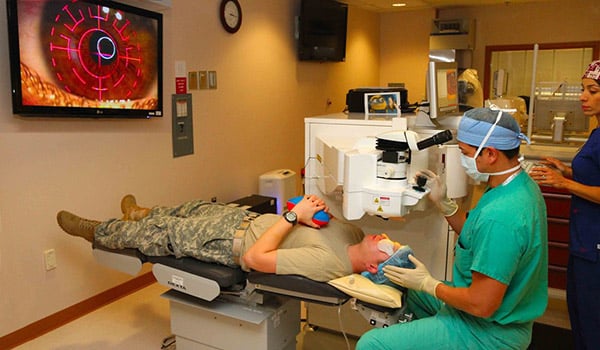
Ask the Flight Surgeon / By MAJ (Dr.) Eric Abdul: The popularity and success of corneal refractive surgery (such as LASIK, LASEK or PRK) has prompted questions from those applying for Aviation duty. Here is an introduction to the topic for initial applicants.

Photo: Army.mil
FS: Light enters the eye through the clear portion of its front known as the cornea. The cornea refracts, or bends, incoming light through the lens and directs it onto the retina at the back of the eye. Most of the refractive power of the eye resides in the spherical shape of the cornea, with the lens acting to adjust focus for near and far vision. A uniform and appropriately shaped cornea produces a clear image. But a refractive error of the cornea can cause the image to focus in front or behind the retina, making you near or far-sighted, respectively. If the refractive power of the cornea varies across its surface and is not uniform, it may produce a distorted image (i.e. astigmatism). Glasses or contact lenses may be able to improve your vision to meet Aviation standards. However, it is understandable why a future aviator might want to avoid the requirement to wear them during flight and carry a spare in their flight bag, especially in an austere environment. Surgery to correct your corneal refraction is an attractive option, but as with any medical procedure, the decision should not be taken lightly. Discuss with your Ophthalmologist the risks, benefits, and alternatives to these procedures, as well as which type of surgery they recommend. Complications are a risk for any surgery, and in this case include the need for more treatments, corneal haze, decrease in contrast, halos, or glare at night. Please note that for those already in the service, Commander’s approval is required before undertaking corneal refractive surgery.
Surgical Options
LASIK, LASEK, and PRK are all types of corneal refractive surgery and can be approved for Aviation duty in the Army. These procedures are slightly different from one another, but all use a laser to reshape the cornea. Speaking generally, outcomes and recovery times are very similar for all three procedures. In LASIK the top layer of the cornea is cut and pulled back to expose the middle of the cornea for reshaping, after which the outer flap is returned to its original position. It may be a good choice for those with severe near-sightedness. LASEK is somewhat like LASIK but is done with a thinner flap and is performed closer to the surface. There are fewer complications related to the flap itself, but it may have more short-term discomfort immediately after the procedure and may be less appropriate for very near-sighted individuals. PRK also treats the outer surface of the cornea. But instead of creating a flap, the protective skin-cell covering (epithelium) is gently removed. The laser then sculpts the functional part of the cornea beneath. The protective skin layer grows back in a matter of days, but there is often discomfort and protective lenses and antibiotic drops must be used during the healing time. That’s a very basic review of the procedures, and again it’s best to discuss your preference with your Ophthalmologist who can help you choose a procedure, if any, that is right for you. Regardless of technique, the earliest your post-operative outcome can be evaluated for an Army flight physical is three months after the surgery.
Do Your Research
I encourage you to also discuss your case before surgery with an Army Flight Surgeon and/or an Optometrist with Army aeromedical experience. Your recruiter, ROTC or cadet command, or non-flight qualified military medical provider should be able to assist in locating and contacting an appropriate aeromedical provider. You may wish to obtain your optometry records beforehand, which will assist that aeromedical provider in assessing your case. Some visual defects are not amenable to corneal refractive surgery or an individuals’ astigmatism or near/far sightedness may be too severe to be corrected within the limits of the Army’s aeromedical policy. Under these circumstances, they may need to consult your waiver approval authority on your behalf (Human Resource Command for Active Duty and Reserves and the National Guard Bureau for Guardsmen) to determine aeromedical appropriateness of a procedure. The aeromedical provider or approval authority can also give you and your medical team the Army’s criteria for postoperative outcomes that meet the eligibility criteria. If refractive surgery is the right choice, be sure to bring your preoperative, treatment, and postoperative records with you to your flight physical. Be aware that some individuals who undergo refractive surgery improve their vision but are still required to wear corrective lenses to raise their visual acuity to qualifying levels.
When To Act
Another consideration for some applicants interested in refractive surgery may be timing. For instance, if you currently qualify for Aviation duty with corrective lenses you may opt to complete initial flight training before seeking refractive surgery. Bear in mind that aside from the need to obtain command permission you will also need to find a period in your career where you will be ineligible to fly for six to twelve weeks, or potentially longer if there are complications during your surgical recovery. Finding that right time for interested individuals may require a year or two of planning in advance to determine the right window.
Fly safe!
MAJ Eric Abdul, M.D. is a flight surgeon at the U.S. Army School of Aviation Medicine, Fort Rucker, AL.










